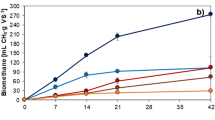Abstract
A large amont of rejected materials and their pollution can create multiple challenges in terms of sustainable development, law, and the environment. Faced with this problem, it is necessary to study and develop methods that make it possible to extract or stabilize pollutants in the biotope matrix (sediment, soils, and water) before storage and possible recovery operations. Different cases were presented, namely, (I)a bioremediation of urban wastewater by microalgae (phytoremedaition), (II) bioremediation of industrial wastewater using anaerobic digestion (using anaerobic microorganisms) and solid fermentation (using fungi), (III) bioremdiation of sediment and sludge using anaerobic consortia (remediation associated with bioenergy production), and (IV) bioremediation using biosurfactant microorganisms’ activity. In addition, the effect of an economic and environmental bioremediation study was carefully discussed in this chapter. In fact, the use of bioremediation process is in perfect harmony with recent sustainable environmental development.
Access this chapter
Tax calculation will be finalised at checkout
Purchases are for personal use only
Similar content being viewed by others
Notes
- 1.
This trend in the economics of sustainable development shows the extent to which the health-environment field must integrate multiple, different and complementary disciplines, approaches and points of view, in this case the economic, ecological and social dimensions.
- 2.
It should be noted that economic development is the expression of a strong and sustained expansion of material production (growth of the Gross Domestic Product (GDP) or of national income) associated with a reduction in monetary poverty and progress in health and education and the universalization of real freedoms. Development is a qualitative phenomenon taking into account the economic and social dimensions, it is measured thanks to the HDI.
- 3.
Sustainability is a situation in which the current level of well-being can at least be maintained for future generations, which supposes measuring the quantitative and qualitative evolution of the stocks of heritage on the basis of our well-being.
References
Garcia‐Mancha N, Puyol D, Monsalvo VM, Rajhi H, Mohedano AF, Rodriguez JJ (2012) Anaerobic treatment of wastewater from used industrial oil recovery. J Chem Technol Biotechnol 87:1320. https://doi.org/10.1002/jctb.3753
Giasson P, Jaouich A, Gagné S, Moutoglis P (2005) Phytoremediation of zinc and cadmium: a study of arbuscular mycorrhizal hyphae. Remediat J 15(4):113–122
Glass DJ (1999) Current market trends in phytoremediation. Int J Phytoremediation 1(1):1–8
Kuznets S (1955) Economic growth and income inequality. Am Econ Rev 45(1):1–28
Mnif I, Rajhi R, Bouallegue A, Trabelsi N, Ghribi D (2021) Characterization of lipopeptides biosurfactants produced by a newly isolated strain bacillus subtilis ZNI5: potential environmental application. J Polym Environ. https://doi.org/10.21203/rs.3.rs-308797/v1
Newman LA, Strand SE, Choe N, Duffy J, Ekuan G, Ruszaj M, Shurtleff BB, Wilmoth J, Heilman P, Gordon MP (1997) Uptake and biotransformation of trichloroethylene by hybrid poplars. Environ Sci Technol 31(4):1062–1067
Olson P, Reardon K, Pilon-Smits E (2004) Ecology of rhizosphere bioremediation. In: Phytoremediation: transformation and control of contaminants (vol. 121), p. 317
Peer WA, Baxter IR, Richards EL, Freeman JL, Murphy AS (2005) Phytoremediation and hyperaccumulator plants. In: Molecular biology of metal homeostasis and detoxification. Springer, pp 299–340
Perchet TMG (2008) Sediment bioremediation study contaminated by compounds organic persistent niters (Tessis doctoral)
Pilon-Smits E (2005) Phytoremediation. Ann Rev Plant Biol 56:15–39
Puyol D, Rajhi H, Mohedano AF, Rodríguez JJ, Sanz JL (2011) Anaerobic biodegradation of 2,4,6-trichlorophenol in expanded granular sludge bed and fluidized bed biofilm reactors bioaugmented with Desulfitobacterium spp. Water Sci Technol. https://doi.org/10.2166/wst.2011.556
Rajhi H (2012) Biohydrogen production by dark fermentation. A Date of defence: in October 19th, 2012. Place: Department of Molecular Biology, Center of Molecular Biology (CBM), Autónoma university of Madrid (UAM), Madrid - Spain. http://hdl.handle.net/10486/12889
Rajhi H, Diaz EE, Rojas P, Sanz JL (2013a) Microbial consortia for hydrogen production enhancement. Curr Microbiol. https://doi.org/10.1007/s00284-013-0328-3
Rajhi H, Conthe M, Puyol D, Diaz EE, Sanz JL (2013b) Dark fermentation: isolation and characterization of hydrogen producing strains from different sludge’s. Int Microbiol. https://doi.org/10.2436/20.1501.01.180
Rajhi H, Puyol D, Diaz E, Martínez M, Sanz JL (2016) Vacuum promotes metabolic shifts and increase biogenic hydrogen production in dark fermentation systems. Front Environ Sci Eng 10:513–521
Rajhi H, Mnif I, Abichou M, Rhouma A (2018) Assessment and valorization of treated and non-treated olive mill wastewater (OMW) in the dry region. Int J Recycl Org Waste Agric 2018(7):199–210. https://doi.org/10.1007/s40093-018-0206-x
Rajhi H, Bardi A, Sadok S, Moussa M, Turki S (2020) Phytoremediation of samples extracted from wastewater treatment plant and their socioeconomic impact. Water Sci Technol 82(8):2020
Vivien F-D (2005) Sustainable development. Paris, La Découverte, Repères collection
Vivien F-D (2008) Sustainable development: progress, shortcomings and future needs. Cahiers Français, n ° 347, November–December
Acknowledgements
Hayfa Rajhi is grateful to Pr. Jose Luis Sanz Martion (Professor of Microbiology in University Autonoma Madrid–Laboratory of Applied Microbiology) for his supervision and teaching throughout these years in terms of Microbiology and waste Bioremediation field (especially the anaerobic microbiology) as well as the molecular microorganisms techniques. This chapter is specially dedicated to Jose Luis Sanz Martin and his laboratory member.
Author information
Authors and Affiliations
Editor information
Editors and Affiliations
Rights and permissions
Copyright information
© 2023 The Author(s), under exclusive license to Springer Nature Switzerland AG
About this chapter
Cite this chapter
Rajhi, H., Bardi, A. (2023). Spinoffs of Phyoremediation and/or Microorganism Consortium in Soil, Sediment, and Water Treatments and Improvement: Study of Specific Cases and Its Socioeconomic and Environmental Advantages. In: Newman, L., Ansari, A.A., Gill, S.S., Naeem, M., Gill, R. (eds) Phytoremediation. Springer, Cham. https://doi.org/10.1007/978-3-031-17988-4_9
Download citation
DOI: https://doi.org/10.1007/978-3-031-17988-4_9
Published:
Publisher Name: Springer, Cham
Print ISBN: 978-3-031-17987-7
Online ISBN: 978-3-031-17988-4
eBook Packages: Biomedical and Life SciencesBiomedical and Life Sciences (R0)




